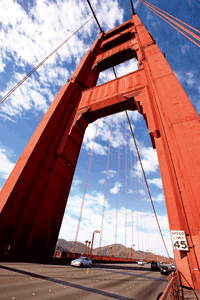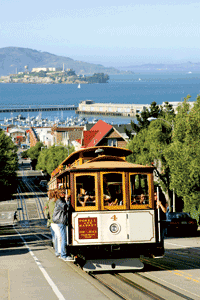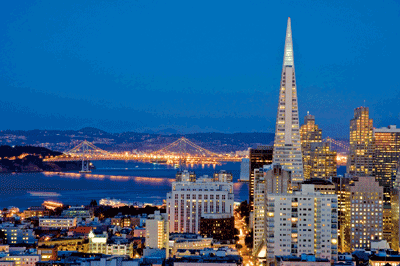The Californian city’s laid-back vibe is reflected in how it does business, says Jenny Southan
Sitting on the right side of the plane, I am lucky enough to see the silvery towers of San Francisco’s financial district, the azure sweep of the bay and the deep orange of the Golden Gate Bridge as I come in to land. With a reputation for being the epicentre of tolerance, thanks to the Summer of Love’s hippie revolution of 1967 and the gay rights movement led by city councillor Harvey Milk in the seventies, this West Coast city is a unique place to do business. And as it is not a sprawling metropolis, covering an area of only seven square miles, it’s easy to get between meetings. San Francisco may be a permanent fixture on the annual calendars of many business travellers, but finding the time to get to know its finer points can be a challenge. Joe D’Alessandro, chief executive of the San Francisco Convention and Visitors Bureau (SFCVB), says that even though it is geographically finite, it is constantly evolving. “We are limited by the water that surrounds us on three sides, so the city can’t sprawl, but it can go up,” he says. “A lot of the new housing developments are high-rise towers that have been built in the past decade. Mission Bay and the South of Market area have both been developed in former warehouse and industrial lands that are now growing neighbourhoods and are becoming quite vibrant.”
Part of San Francisco’s charm is its physical attributes – steep hills and rolling fog, antiquated trams and a conglomeration of districts, each as distinct in terms of its architecture, population and history as the next. But it’s also a cultural melting pot. Angela Jackson, director of public relations for the SFCVB, says: “Anything goes here – a drag queen could walk through the financial district and no one would bat an eyelid.”
San Francisco may be a permanent fixture on the annual calendars of many business travellers, but finding the time to get to know its finer points can be a challenge. Joe D’Alessandro, chief executive of the San Francisco Convention and Visitors Bureau (SFCVB), says that even though it is geographically finite, it is constantly evolving. “We are limited by the water that surrounds us on three sides, so the city can’t sprawl, but it can go up,” he says. “A lot of the new housing developments are high-rise towers that have been built in the past decade. Mission Bay and the South of Market area have both been developed in former warehouse and industrial lands that are now growing neighbourhoods and are becoming quite vibrant.”
Part of San Francisco’s charm is its physical attributes – steep hills and rolling fog, antiquated trams and a conglomeration of districts, each as distinct in terms of its architecture, population and history as the next. But it’s also a cultural melting pot. Angela Jackson, director of public relations for the SFCVB, says: “Anything goes here – a drag queen could walk through the financial district and no one would bat an eyelid.”
 When it comes to meeting clients and signing contracts, it is the progressive nature of San Franciscans that really strikes you. D’Alessandro says: “Business is conducted in a very different way – it’s more casual and less stressful. People have a great love of the outdoors and the natural surroundings, and this is carried through into the way business is conducted. If you go to the campuses of Google or one of the other high-tech internet companies here, you will see guys going around on skateboards.”
For locals, the key to success is creating a happy balance between work and leisure. “We rate quality of life highly, and that doesn’t apply just to weekends but on a daily basis and in how we work,” D’Alessandro says. “The most successful way to do business here is to tap into our psyche. For example, especially with the younger generation, you are seeing fewer people in suits. People dress appropriately – you don’t see workers in cut-off jeans necessarily, but they dress for comfort. If you’re here on business, do it a little more casually – enjoy it.”
When I visited in the spring, this positive outlook shone through even at a time when the global recession was taking hold. I was assured by numerous residents that San Francisco was the last city in the US to enter the downturn and would be the first to come out of it. Six months on and the picture is mixed. D’Alessandro says: “I think we are experiencing similar business travel patterns as other cities around the world. Saying that, hotel occupancy and meetings and conventions have all been strong this summer, but the business side of it is still not where it was pre-recession. Many companies are sending fewer people on trips and their overall spending on hotels and entertainment is down.”
The average daily hotel rate has dropped 17 per cent compared with this time last year, and combined with an improved pound-to-dollar exchange rate (approximately £1/US$1.65), this means better value for money for executives coming from the UK. But this doesn’t necessarily mean they are flashing the cash, as Peter Koehler, general manager of the InterContinental San Francisco, explains. “The individual business traveller has become more image conscious – whereas before it was about status and power, opting for more luxurious and opulent choices, now it’s about being practical and modest,” he says.
In autumn last year, a number of major conventions brought about 50,000 people into San Francisco – a big influx for a population of only 800,000 – resulting in a sell-out situation not only for the city but for the whole Bay area. Even so, those in the know are cautious about predicting what this year will bring in terms of business travel. Koehler says: “Unfortunately, the repercussions of the recession won’t lift as quickly as we would like. Most of the forecasts are indicating that it will still be a difficult year for the hotel industry, well into at least the third quarter of 2010.”
Like many other business cities around the world, the high-end hotel market is experiencing a tough time, and although brands such as InterContinental, Four Seasons, Ritz-Carlton and St Regis have loyal clients, it will take time to fully recover. D’Alessandro doesn’t anticipate any new hotel openings in the next few years.
When it comes to meeting clients and signing contracts, it is the progressive nature of San Franciscans that really strikes you. D’Alessandro says: “Business is conducted in a very different way – it’s more casual and less stressful. People have a great love of the outdoors and the natural surroundings, and this is carried through into the way business is conducted. If you go to the campuses of Google or one of the other high-tech internet companies here, you will see guys going around on skateboards.”
For locals, the key to success is creating a happy balance between work and leisure. “We rate quality of life highly, and that doesn’t apply just to weekends but on a daily basis and in how we work,” D’Alessandro says. “The most successful way to do business here is to tap into our psyche. For example, especially with the younger generation, you are seeing fewer people in suits. People dress appropriately – you don’t see workers in cut-off jeans necessarily, but they dress for comfort. If you’re here on business, do it a little more casually – enjoy it.”
When I visited in the spring, this positive outlook shone through even at a time when the global recession was taking hold. I was assured by numerous residents that San Francisco was the last city in the US to enter the downturn and would be the first to come out of it. Six months on and the picture is mixed. D’Alessandro says: “I think we are experiencing similar business travel patterns as other cities around the world. Saying that, hotel occupancy and meetings and conventions have all been strong this summer, but the business side of it is still not where it was pre-recession. Many companies are sending fewer people on trips and their overall spending on hotels and entertainment is down.”
The average daily hotel rate has dropped 17 per cent compared with this time last year, and combined with an improved pound-to-dollar exchange rate (approximately £1/US$1.65), this means better value for money for executives coming from the UK. But this doesn’t necessarily mean they are flashing the cash, as Peter Koehler, general manager of the InterContinental San Francisco, explains. “The individual business traveller has become more image conscious – whereas before it was about status and power, opting for more luxurious and opulent choices, now it’s about being practical and modest,” he says.
In autumn last year, a number of major conventions brought about 50,000 people into San Francisco – a big influx for a population of only 800,000 – resulting in a sell-out situation not only for the city but for the whole Bay area. Even so, those in the know are cautious about predicting what this year will bring in terms of business travel. Koehler says: “Unfortunately, the repercussions of the recession won’t lift as quickly as we would like. Most of the forecasts are indicating that it will still be a difficult year for the hotel industry, well into at least the third quarter of 2010.”
Like many other business cities around the world, the high-end hotel market is experiencing a tough time, and although brands such as InterContinental, Four Seasons, Ritz-Carlton and St Regis have loyal clients, it will take time to fully recover. D’Alessandro doesn’t anticipate any new hotel openings in the next few years.









